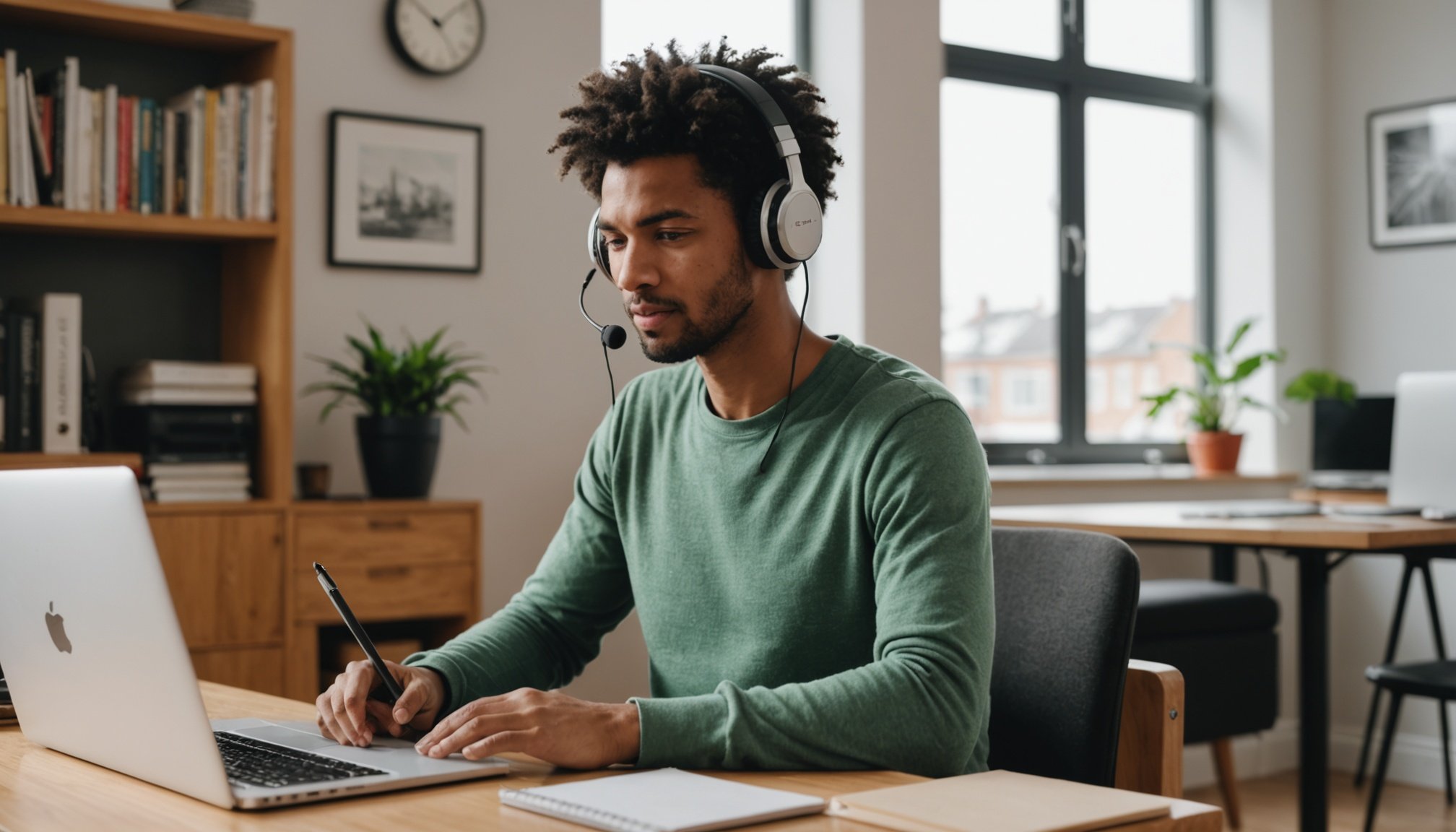Importance of a Noise-Free Environment for Online Teaching
Creating a noise-free classroom is essential for both educators and students. Distractions from background noise can significantly impact online teaching focus, reducing the effectiveness of lessons and leading to a drop in teaching productivity. A quiet environment ensures that learners can engage fully with the material, retaining information more effectively.
The psychological benefits of a distraction-free space cannot be overstated. Noise can increase stress and reduce concentration levels, making it difficult for teachers to convey concepts clearly and for students to absorb them. This can lead to frustration on both sides, hampering the educational process.
Also read : Unlock budget-friendly techniques for installing underfloor heating in concrete surfaces
Real-life examples underline these challenges. Educators who live in bustling environments, such as urban areas, often find it hard to maintain a quiet teaching space. This not only affects their role as educators but also diminishes the learning experience for students. Understanding and addressing these issues is critical. Implementing effective solutions to minimize noise can significantly enhance educational outcomes, allowing for better engagement and improved teaching productivity.
Soundproofing Techniques for Home Teaching Spaces
In a home classroom, maintaining good acoustics is essential to ensure instructional clarity and minimize distractions. One of the simplest soundproofing methods involves using thick curtains or rugs to absorb sound. These materials can be both cost-effective and efficient in damping noise.
Also read : Illuminate your imagination: crafting your ideal home library bathed in natural light
For more extensive noise reduction, consider acoustic panels or foam tiles. These are designed to improve room acoustics by reducing echo, which is beneficial in any teaching environment. DIY soundproofing tips also suggest weather stripping for windows or doors to block external noise.
Educators on a budget can rearrange furniture strategically to block out sounds. Bookshelves or large soft furnishings act as sound barriers, offering a practical solution for many educators faced with financial constraints.
Real-life examples highlight educators converting spaces like closets into isolated teaching zones using inexpensive foam board insulation. Such case studies emphasize creativity in implementing noise reduction strategies without professional aid. These upgrades significantly raise the quality of the teaching experience, fostering a more immersive and engaging learning environment for students. By investing in soundproofing, educators can enhance their online teaching focus and teaching productivity.
Organizing Your Teaching Space for Maximum Focus
Creating an organized teaching space is crucial for maximizing focus. Firstly, decluttering is vital. A clutter-free environment boosts concentration and minimizes distractions. Arrange items in order of necessity to streamline access to teaching materials.
When it comes to furniture and technology, strategic placement is key. Position your desk to face away from high-traffic areas in your home to reduce interruptions. Ensure technology, such as computers and projectors, is easily accessible yet not intrusive.
Consider creating a dedicated teaching zone. This not only enhances focus but delineates professional space from personal, reducing potential disruptions. If space constraints necessitate a multi-use environment, use visual cues to mark your teaching zone when in use.
Educators often employ bookshelves as dividers to subtly separate teaching spaces, demonstrating workspace optimization. Such techniques promote a professional atmosphere conducive to productivity.
Incorporating these methods fosters a focused, distraction-managed teaching environment that supports both educator and student success. Remember, a well-organized area doesn’t just enhance focus but also instills discipline and routine in sessions.
Managing Home Distractions While Teaching
Effectively managing home distractions is crucial for maintaining a productive teaching environment. One fundamental strategy is establishing clear boundaries with household members. Engage in a candid discussion to communicate focus strategies and set specific times during which interruptions should be minimized. This helps to maintain a professional atmosphere even at home.
Implementing structured schedules and routines is another efficient technique. By dedicating set times to teaching tasks, it becomes easier to predict and reduce interruptions. Consistency in routines also helps in creating a stable teaching environment, which benefits concentration levels significantly.
Incorporating tactics to maintain concentration is equally important. During lessons, utilise simple techniques such as setting timer intervals for focused work and allowing short breaks to refresh the mind. This applies particularly in environments filled with potential distractions.
To bolster these strategies, consider using noise-cancelling headphones or white noise machines. Both can aid in controlling external disturbances. Equipping oneself with the right tools and engaging household cooperation ensures a teaching environment conducive to success. Employing these practices can dramatically enhance your potential to manage distractions effectively and focus on educational objectives.
Tools and Technologies to Enhance Audio Quality
With the importance of audio quality in online teaching, selecting the right audio technology is crucial for educators. High-quality microphones, such as condenser types, capture clear sound and enhance communication with students. Popular models include the Audio-Technica AT2020 and the Blue Yeti, both of which offer exceptional sound clarity at affordable prices.
Noise-cancelling headphones are indispensable tools for minimizing external disturbances. They allow teachers to focus on delivering lessons by blocking ambient noise. Brands like Bose and Sony are frequently recommended for their superior noise-cancellation features.
Software tools also play a significant role in achieving a noise-free environment. Programs such as Krisp and Nvidia RTX Voice offer advanced noise cancellation for online teaching sessions. These tools filter out unwanted sounds, ensuring that both teachers and students have an optimal listening experience.
In addition, teaching equipment for recording lessons can be enhanced using audio interfaces. These devices facilitate sound management by connecting microphones to computers easily and efficiently. Investing in the right equipment and technologies enables educators to deliver quality sound solutions without interruptions, enhancing the overall educational experience.
Personal Anecdotes and Expert Opinions
Exploring teacher experiences with noise challenges provides invaluable insights into practical solutions. Many educators recount transforming chaotic home offices into serene learning environments. One teacher from a bustling city found peace by investing in modest but effective soundproofing methods like dense curtains and acoustic panels, significantly improving their online teaching focus.
Experts emphasize the significance of balanced acoustic solutions, advocating for a blend of technological aids like noise-cancelling headphones and considerate space organization. Recommendations center around DIY soundproofing tips, such as rearranging furniture to enhance acoustics or using bookcases as sound barriers—strategies that also benefit teaching productivity.
Expert advice suggests avoiding common pitfalls, such as neglecting window treatments or overlooking the impact of ambient noise. On a practical scale, integrating effective noise reduction strategies is crucial, yet often underestimated. For instance, professional audio specialists advise leveraging audio technology for teachers, like quality microphones combined with software tools, as essential to maintaining clear communication.
Ultimately, understanding the nexus of technology, personal resourcefulness, and strategic planning equips educators with robust approaches to create optimal teaching environments conducive to both teaching and learning success.
Actionable Steps to Create a Noise-Free Teaching Environment
Creating a noise-free classroom can be achieved through well-thought-out actions. Start by identifying key noise reduction strategies suitable for your space. Thick curtains, rugs, or acoustic panels are accessible for many, dramatically improving home classroom acoustics.
-
Soundproofing Methods: Implement DIY tips like using weather stripping on windows and doors to block external sounds. Affordable items such as foam tiles or dense curtains may be used. If constrained, rearrange bulky furniture or bookshelves as barriers.
-
Teaching Space Organization: Design a dedicated space to separate it from personal areas. This delineation enhances focus and teaching productivity. Utilize furniture strategically to minimize distractions, creating a streamlined teaching environment.
-
Checklists and Habits: Create a preparatory checklist for smooth transition to teaching mode. Ensure tech is ready and noise-cancelling headphones are on hand for unexpected disturbances.
-
Develop habits, such as regular cleanups, to maintain organization and structure. These actionable steps foster a productive and engaging learning atmosphere, benefiting both educators and learners. Aim for a consistent routine that promotes a distraction-free space conducive to focused online teaching.











